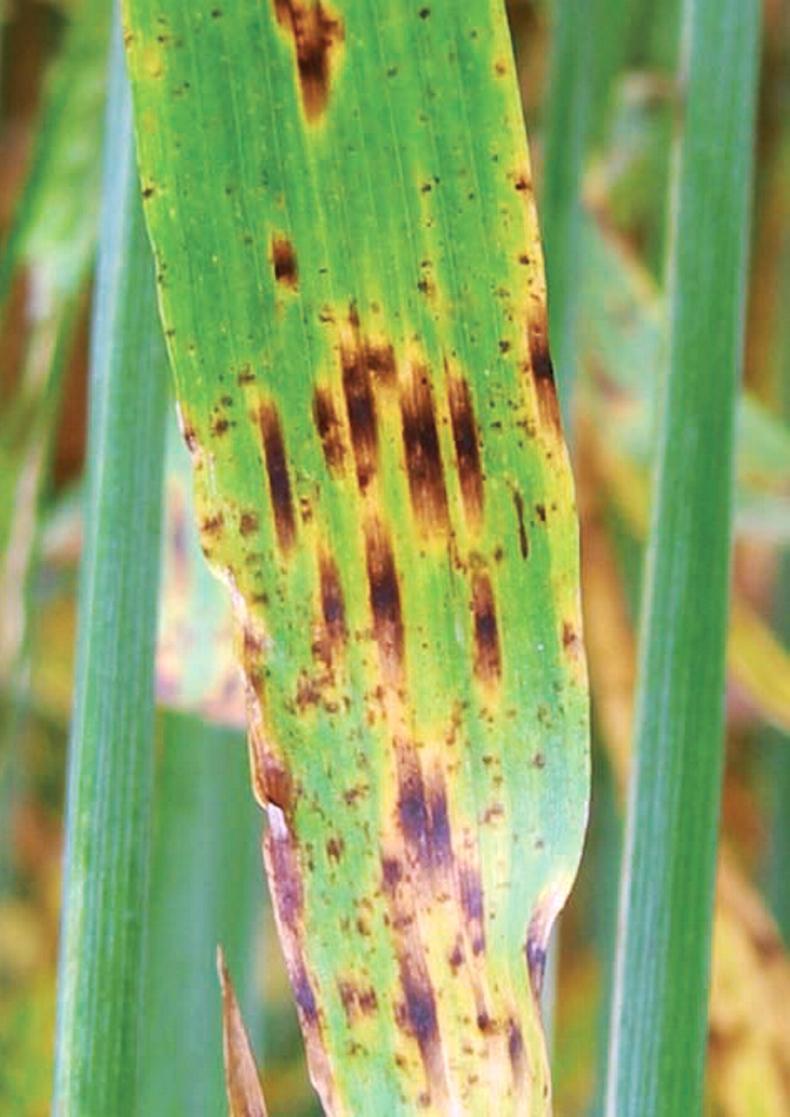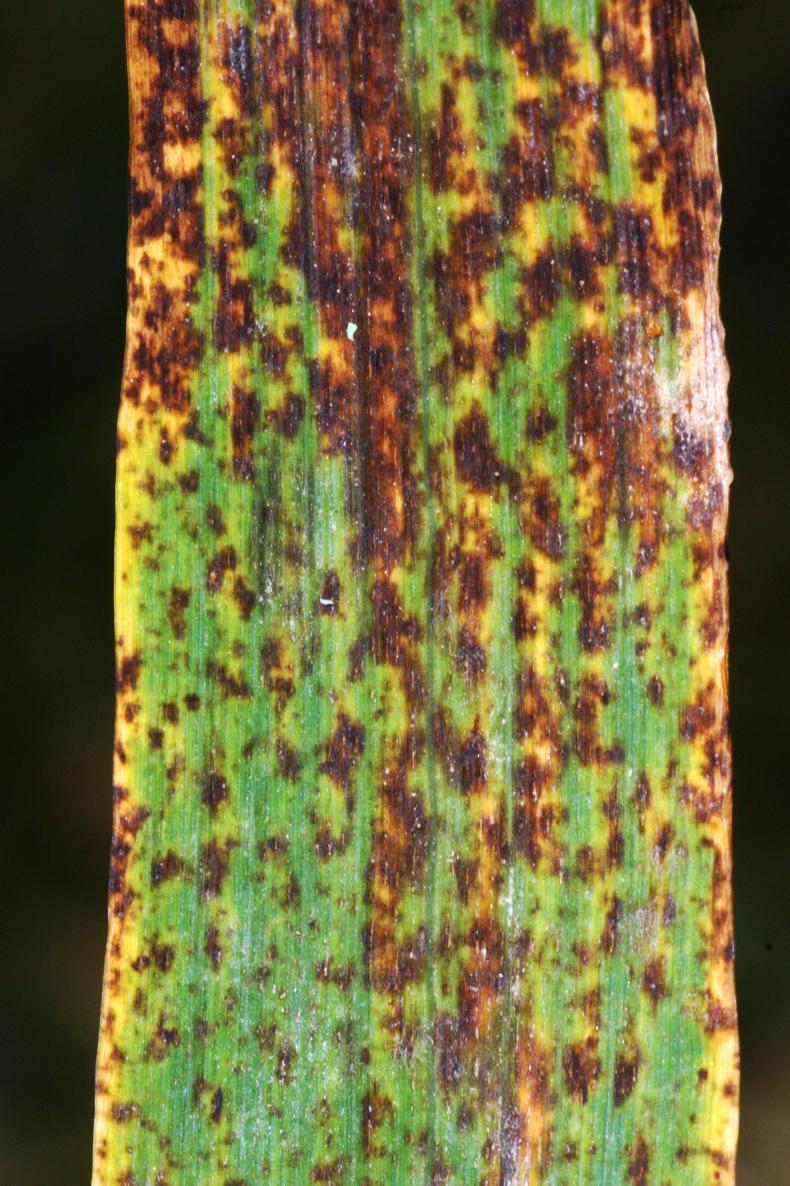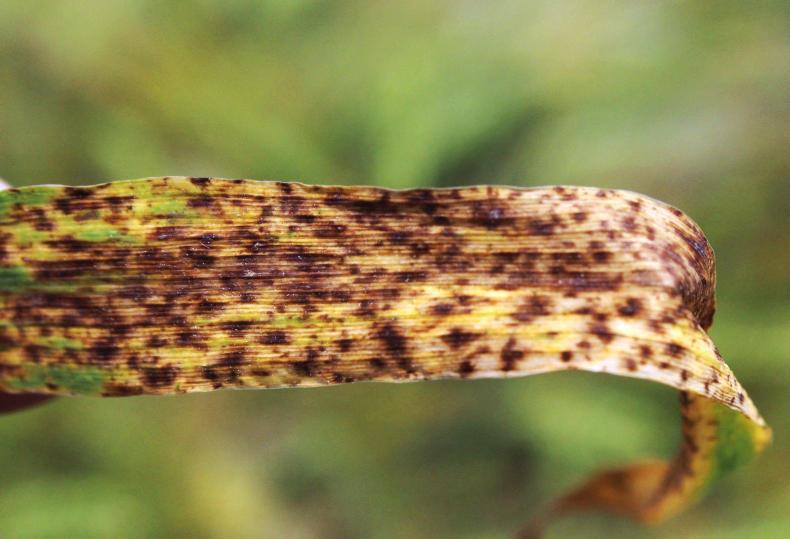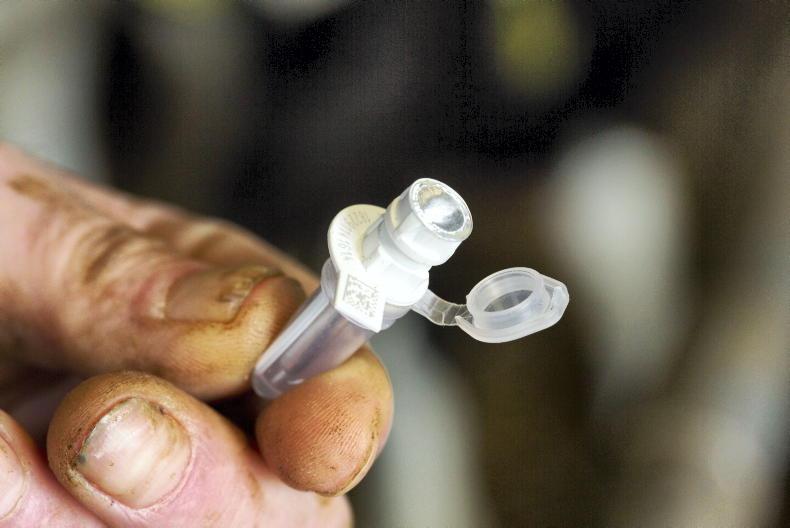Ramularia leaf spot (RLS) is a disease of barley crops across northwestern Europe. While present in most countries, it is only in those countries with a mild and humid environment that it tends to cause significant yield losses.
In Ireland, those climatic conditions prevail and yield losses of up to 1t/ha have been recorded in both spring and winter crops. However, on farms, the disease has not been regarded as a problem until now. Undoubtedly, this has in part been due to the application of fungicides. These applications have often included chlorothalonil and the imminent loss of this active in 2020, coupled with the spread of resistance to the azole and SDHI fungicides in Irish ramularia populations, may change this situation. Therefore, increasing our understanding of RLS and its potential threat to Irish barley crops is of the utmost importance.
Unfortunately, the combination of RLS being a relatively new disease, having only first been recognised as a serious threat to barley production in the late 1990s, and the reliable and extremely effective control that was afforded by chlorothalonil, have meant that limited research has been conducted into understanding the development of the disease.
Identification
The first problem faced by growers, agronomists and researchers in understanding and providing control strategies for RLS is being able to accurately diagnose the disease.
In general, RLS only manifests itself post-flowering and can often be overlooked as natural senescence or physiological leaf spotting. The inability to accurately diagnose the disease presents significant problems for those involved in screening varieties for resistance and, as such, limited data is available on varietal resistance.

Ramularia lesions on a spring barley leaf.
In addition, as the symptoms tend to occur post-flowering, this further increases the difficulty with varietal resistance screening. Assessing disease is a laborious task and varieties are often assessed at single time points. As such, any differences in disease levels that occur may actually be more reflective of the maturity of the crop at that time of assessment than the level of resistance present in the variety. A further difficulty for assessment is that the majority of varieties often have other disease weaknesses, which by flowering have caused significant disease, reducing the capacity to accurately determine the presence of ramularia.
Taken together, limited information is available for farmers in terms of how the variety of barley they grow will perform if conditions favour RLS development. In 2019, DAFM is conducting RLS-specific trials and this will provide invaluable information for future seasons.
Plant stresses
The second aspect that creates problems with controlling RLS is the limited information that is available on why or when the typical spotting symptoms may develop. It is known that stresses imposed on the plant will exacerbate the problem. However, defining stresses in a field crop exposed to the natural elements can be extremely difficult.
Preliminary research from the UK, specifically Scotland, suggests the duration of leaf wetness during stem extension plays a crucial role. Unfortunately in Ireland, for both spring and winter barley, there is a very good chance that the crops during stem extension will be wet for prolonged periods of time, whether directly from rainfall or from heavy evening dews.
Using this criteria, trials were conducted on spring barley to determine if the final fungicide could be tailored to reflect the differences in wetness duration that occurred. The levels of disease that were recorded were related to leaf surface wetness, with the longer durations recorded in 2016 and 2017 showing more symptoms.

Ramularia control may prove challenging in the absence of a durable contact alternative to chlorothalonil.
On those with lower symptoms it was possible to reduce the fungicide programme, either in terms of fungicides used or dose rate applied.
Equally, it demonstrated that in those trials with a prolonged leaf surface wetness it was not necessary to increase the dose or increase the fungicides applied.
While this gave confidence that what was being recommended was effective even in the most high pressure situations, the recommended programmes included chlorothalonil.
Further research is now required to determine if alternative multi-site fungicides can be used instead of chlorothalonil.
Additionally, as stresses are a factor in symptom development, we must examine whether specific aspects of barley husbandry can be altered to alleviate stresses that trigger the disease.
Seed borne
Finally, ramularia is known to be seed-borne. Intensive detection of ramularia in Irish seed stocks has confirmed that it is present in Irish seed, albeit at relatively low levels and not necessarily in all seed stocks.
Read more
Tillage management: crop season almost at an end for inputs
Crops & Spreaders is a must
Year is moving on as most crops ready for final fungicide
Ramularia leaf spot (RLS) is a disease of barley crops across northwestern Europe. While present in most countries, it is only in those countries with a mild and humid environment that it tends to cause significant yield losses.
In Ireland, those climatic conditions prevail and yield losses of up to 1t/ha have been recorded in both spring and winter crops. However, on farms, the disease has not been regarded as a problem until now. Undoubtedly, this has in part been due to the application of fungicides. These applications have often included chlorothalonil and the imminent loss of this active in 2020, coupled with the spread of resistance to the azole and SDHI fungicides in Irish ramularia populations, may change this situation. Therefore, increasing our understanding of RLS and its potential threat to Irish barley crops is of the utmost importance.
Unfortunately, the combination of RLS being a relatively new disease, having only first been recognised as a serious threat to barley production in the late 1990s, and the reliable and extremely effective control that was afforded by chlorothalonil, have meant that limited research has been conducted into understanding the development of the disease.
Identification
The first problem faced by growers, agronomists and researchers in understanding and providing control strategies for RLS is being able to accurately diagnose the disease.
In general, RLS only manifests itself post-flowering and can often be overlooked as natural senescence or physiological leaf spotting. The inability to accurately diagnose the disease presents significant problems for those involved in screening varieties for resistance and, as such, limited data is available on varietal resistance.

Ramularia lesions on a spring barley leaf.
In addition, as the symptoms tend to occur post-flowering, this further increases the difficulty with varietal resistance screening. Assessing disease is a laborious task and varieties are often assessed at single time points. As such, any differences in disease levels that occur may actually be more reflective of the maturity of the crop at that time of assessment than the level of resistance present in the variety. A further difficulty for assessment is that the majority of varieties often have other disease weaknesses, which by flowering have caused significant disease, reducing the capacity to accurately determine the presence of ramularia.
Taken together, limited information is available for farmers in terms of how the variety of barley they grow will perform if conditions favour RLS development. In 2019, DAFM is conducting RLS-specific trials and this will provide invaluable information for future seasons.
Plant stresses
The second aspect that creates problems with controlling RLS is the limited information that is available on why or when the typical spotting symptoms may develop. It is known that stresses imposed on the plant will exacerbate the problem. However, defining stresses in a field crop exposed to the natural elements can be extremely difficult.
Preliminary research from the UK, specifically Scotland, suggests the duration of leaf wetness during stem extension plays a crucial role. Unfortunately in Ireland, for both spring and winter barley, there is a very good chance that the crops during stem extension will be wet for prolonged periods of time, whether directly from rainfall or from heavy evening dews.
Using this criteria, trials were conducted on spring barley to determine if the final fungicide could be tailored to reflect the differences in wetness duration that occurred. The levels of disease that were recorded were related to leaf surface wetness, with the longer durations recorded in 2016 and 2017 showing more symptoms.

Ramularia control may prove challenging in the absence of a durable contact alternative to chlorothalonil.
On those with lower symptoms it was possible to reduce the fungicide programme, either in terms of fungicides used or dose rate applied.
Equally, it demonstrated that in those trials with a prolonged leaf surface wetness it was not necessary to increase the dose or increase the fungicides applied.
While this gave confidence that what was being recommended was effective even in the most high pressure situations, the recommended programmes included chlorothalonil.
Further research is now required to determine if alternative multi-site fungicides can be used instead of chlorothalonil.
Additionally, as stresses are a factor in symptom development, we must examine whether specific aspects of barley husbandry can be altered to alleviate stresses that trigger the disease.
Seed borne
Finally, ramularia is known to be seed-borne. Intensive detection of ramularia in Irish seed stocks has confirmed that it is present in Irish seed, albeit at relatively low levels and not necessarily in all seed stocks.
Read more
Tillage management: crop season almost at an end for inputs
Crops & Spreaders is a must
Year is moving on as most crops ready for final fungicide











SHARING OPTIONS